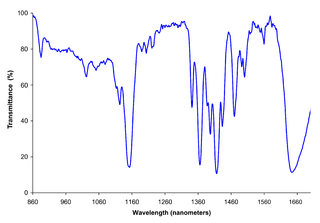
In physics, electromagnetic radiation (EMR) consists of waves of the electromagnetic (EM) field, which propagate through space and carry momentum and electromagnetic radiant energy.

Infrared is electromagnetic radiation (EMR) with wavelengths longer than that of visible light but shorter than microwaves. The infrared spectral band begins with waves that are just longer than those of red light, so IR is invisible to the human eye. IR is generally understood to include wavelengths from around 750 nm (400 THz) to 1 mm (300 GHz). IR is commonly divided between longer-wavelength thermal IR, emitted from terrestrial sources, and shorter-wavelength IR or near-IR, part of the solar spectrum. Longer IR wavelengths (30–100 μm) are sometimes included as part of the terahertz radiation band. Almost all black-body radiation from objects near room temperature is in the IR band. As a form of electromagnetic radiation, IR carries energy and momentum, exerts radiation pressure, and has properties corresponding to both those of a wave and of a particle, the photon.

Infrared spectroscopy is the measurement of the interaction of infrared radiation with matter by absorption, emission, or reflection. It is used to study and identify chemical substances or functional groups in solid, liquid, or gaseous forms. It can be used to characterize new materials or identify and verify known and unknown samples. The method or technique of infrared spectroscopy is conducted with an instrument called an infrared spectrometer which produces an infrared spectrum. An IR spectrum can be visualized in a graph of infrared light absorbance on the vertical axis vs. frequency, wavenumber or wavelength on the horizontal axis. Typical units of wavenumber used in IR spectra are reciprocal centimeters, with the symbol cm−1. Units of IR wavelength are commonly given in micrometers, symbol μm, which are related to the wavenumber in a reciprocal way. A common laboratory instrument that uses this technique is a Fourier transform infrared (FTIR) spectrometer. Two-dimensional IR is also possible as discussed below.

Spectroscopy is the field of study that measures and interprets electromagnetic spectrum. In narrower contexts, spectroscopy is the precise study of color as generalized from visible light to all bands of the electromagnetic spectrum.

The visible spectrum is the band of the electromagnetic spectrum that is visible to the human eye. Electromagnetic radiation in this range of wavelengths is called visible light . The optical spectrum is sometimes considered to be the same as the visible spectrum, but some authors define the term more broadly, to include the ultraviolet and infrared parts of the electromagnetic spectrum as well, known collectively as optical radiation.
Infrared astronomy is a sub-discipline of astronomy which specializes in the observation and analysis of astronomical objects using infrared (IR) radiation. The wavelength of infrared light ranges from 0.75 to 300 micrometers, and falls in between visible radiation, which ranges from 380 to 750 nanometers, and submillimeter waves.

The Very Large Telescope (VLT) is an astronomical facility operated since 1998 by the European Southern Observatory, located on Cerro Paranal in the Atacama Desert of northern Chile. It consists of four individual telescopes, each equipped with a primary mirror that measures 8.2 meters in diameter. These optical telescopes, named Antu, Kueyen, Melipal, and Yepun, are generally used separately but can be combined to achieve a very high angular resolution. The VLT array is also complemented by four movable Auxiliary Telescopes (ATs) with 1.8-meter apertures.

The W. M. Keck Observatory is an astronomical observatory with two telescopes at an elevation of 4,145 meters (13,600 ft) near the summit of Mauna Kea in the U.S. state of Hawaii. Both telescopes have 10 m (33 ft) aperture primary mirrors, and, when completed in 1993 and 1996, they were the largest optical reflecting telescopes in the world. They have been the third and fourth largest since 2006.

Vipers are snakes in the family Viperidae, found in most parts of the world, except for Antarctica, Australia, Hawaii, Madagascar, New Zealand, Ireland, and various other isolated islands. They are venomous and have long, hinged fangs that permit deep penetration and injection of their venom. Three subfamilies are currently recognized. They are also known as viperids. The name "viper" is derived from the Latin word vipera, -ae, also meaning viper, possibly from vivus ("living") and parere, referring to the trait viviparity common in vipers like most of the species of Boidae.

Near-infrared spectroscopy (NIRS) is a spectroscopic method that uses the near-infrared region of the electromagnetic spectrum. Typical applications include medical and physiological diagnostics and research including blood sugar, pulse oximetry, functional neuroimaging, sports medicine, elite sports training, ergonomics, rehabilitation, neonatal research, brain computer interface, urology, and neurology. There are also applications in other areas as well such as pharmaceutical, food and agrochemical quality control, atmospheric chemistry, combustion research and knowledge.

In infrared photography, the photographic film or image sensor used is sensitive to infrared light. The part of the spectrum used is referred to as near-infrared to distinguish it from far-infrared, which is the domain of thermal imaging. Wavelengths used for photography range from about 700 nm to about 900 nm. Film is usually sensitive to visible light too, so an infrared-passing filter is used; this lets infrared (IR) light pass through to the camera, but blocks all or most of the visible light spectrum; these filters thus look black (opaque) or deep red.
In astronomy, a photometric system is a set of well-defined passbands, with a known sensitivity to incident radiation. The sensitivity usually depends on the optical system, detectors and filters used. For each photometric system a set of primary standard stars is provided.

Wide-field Infrared Survey Explorer was a NASA infrared astronomy space telescope in the Explorers Program launched in December 2009. WISE discovered thousands of minor planets and numerous star clusters. Its observations also supported the discovery of the first Y-type brown dwarf and Earth trojan asteroid. WISE performed an all-sky astronomical survey with images in 3.4, 4.6, 12 and 22 μm wavelength range bands, over ten months using a 40 cm (16 in) diameter infrared telescope in Earth orbit.
The deepwater catshark is a species of shark belonging to the family Pentanchidae, the deepwater catsharks. This shark is found in the western Atlantic from Delaware Bay to Suriname, and in the eastern Atlantic from Morocco to northwest Africa. An important key factor to understanding these creatures is ageing, many deepwater Apristurus profundorum have poorly calcified vertebrae that lack visible growth bands, and most do not have dorsal fin spines that can be used for ageing. Other methods, such as captive growth and tag-recapture, are also limited in their suitability for deepwater chondrichthyans due to difficulties in the deep sea.

A camera trap is a camera that is automatically triggered by motion in its vicinity, like the presence of an animal or a human being. It is typically equipped with a motion sensor—usually a passive infrared (PIR) sensor or an active infrared (AIR) sensor using an infrared light beam.

Fourier transform infrared spectroscopy (FTIR) is a technique used to obtain an infrared spectrum of absorption or emission of a solid, liquid, or gas. An FTIR spectrometer simultaneously collects high-resolution spectral data over a wide spectral range. This confers a significant advantage over a dispersive spectrometer, which measures intensity over a narrow range of wavelengths at a time.

Cerium(III) fluoride (or cerium trifluoride), CeF3, is an ionic compound of the rare earth metal cerium and fluorine.

The NIROSETI is an astronomical program to search for artificial signals in the optical (visible) and near infrared (NIR) wavebands of the electromagnetic spectrum. It is the first dedicated near-infrared SETI experiment. The instrument was created by a collaboration of scientists from the University of California, San Diego, Berkeley SETI Research Center at the University of California, Berkeley, University of Toronto, and the SETI Institute. It uses the Anna Nickel 1-m telescope at the Lick Observatory, situated on the summit of Mount Hamilton, east of San Jose, California, USA. The instrument was commissioned on 15 March 2015 and has been operated for more than 150 nights, and is still operational today.

C/2018 Y1 (Iwamoto) is a long period comet with a retrograde orbit discovered on December 18, 2018, by Japanese amateur astronomer Masayuki Iwamoto. Its period is estimated to be 1,733 years. It passed closest to Earth on February 13, 2019. It was expected to reach a magnitude of between 6.5 and 7.5, visible in binoculars or a small telescope and was reported to reach a magnitude of 5.5 by Juan Jose Gonzalez on February 13, before fading to 7.6 two weeks later.
2MASS J11263991−5003550(2MASS J1126−5003) is a brown dwarf about 53 light-years distant from earth. The brown dwarf is notable for an unusual blue near-infrared color. This brown dwarf does not show subdwarf features and the blue color cannot be explained by an unresolved binary. Instead the blue color is explained by patchy clouds. The patchy cloud model allows thick clouds and a cloud coverage of 50% to explain the spectra of 2MASS J1126−5003. Other blue L-dwarfs exist, but are quite rare.















